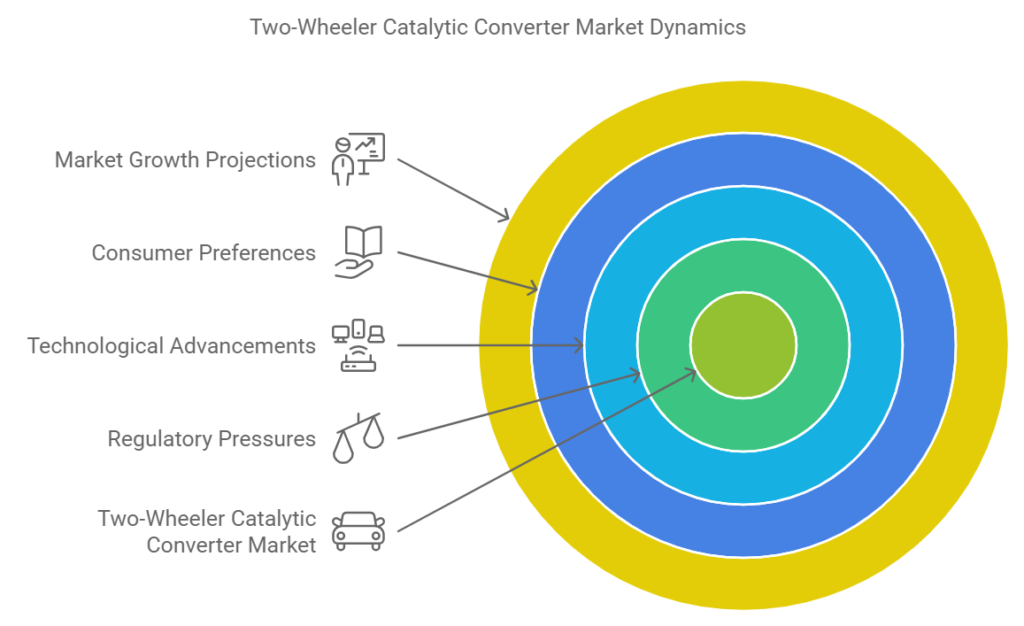Introduction to the Two-Wheeler Catalytic Converter Market
The two-wheeler catalytic converter market plays a crucial role in the automotive sector, particularly in addressing the environmental challenges posed by emissions from motorcycles and scooters. Catalytic converters are essential devices installed in the exhaust systems of two-wheelers to facilitate the conversion of harmful gases into less toxic substances before they are expelled into the atmosphere. These devices primarily target pollutants such as carbon monoxide, nitrogen oxides, and hydrocarbons, significantly contributing to cleaner air and reduced environmental impact.
In light of increasing global concerns regarding air quality and climate change, the adoption of catalytic converters in two-wheelers has gained momentum. Regulations imposed by governmental bodies worldwide aim to mitigate emissions from vehicles, making the use of catalytic converters not only beneficial but often mandatory. For instance, the implementation of stringent emission standards, such as the Euro 5 norms in Europe and BS-VI in India, has catalyzed a significant shift towards cleaner two-wheeler technologies, thereby propelling the demand for efficient catalytic converters.
Consumer preferences have also shifted towards vehicles that offer better fuel efficiency and lower emissions. This growing awareness of sustainable practices among consumers has driven manufacturers to innovate and invest in advanced technologies related to two-wheeler catalytic converters. Key players in the market are focusing on developing high-performance, compact, and affordable catalytic converters that meet regulatory requirements while catering to the expectations of environmentally conscious consumers.
The importance of catalytic converters extends beyond compliance with regulations; they are vital in achieving broader environmental objectives, including greenhouse gas reduction and improving urban air quality. As the two-wheeler catalytic converter market evolves, it is poised for significant growth, influenced by technological advancements, regulatory pressures, and changing consumer expectations. The following sections will delve deeper into the market trends and projections for the years 2024 to 2028.

Market Growth Projections: A Financial Overview
The global two-wheeler catalytic converter market is poised for substantial growth, with projections indicating an increase of approximately USD 560.7 million from 2024 to 2028. This growth trajectory suggests a strong future for this sector, driven by various factors, including tightening emissions regulations, advancements in catalytic converter technology, and an overall rise in two-wheeler production and sales worldwide.
One of the primary drivers of this anticipated growth is the increasing focus on environmental sustainability. Governments across numerous regions are implementing stringent emissions standards, compelling manufacturers to invest in advanced exhaust systems that incorporate state-of-the-art catalytic converters. Consequently, the market is expected to benefit from an uptick in demand for vehicles equipped with these enhanced components. Furthermore, the evolution of technology in the automotive industry is facilitating the development of more efficient, durable, and cost-effective catalytic converters, which will likely bolster market expansion.
Additionally, the growth in urbanization and the rising preference for two-wheelers as a primary mode of transportation, particularly in developing regions such as Asia-Pacific and Latin America, are contributing to the increasing market size. These regions are witnessing a rapid rise in the number of two-wheeler owners, further augmenting the demand for catalytic converters. As a result, the two-wheeler catalytic converter market is projected to experience an impressive compound annual growth rate (CAGR) of approximately 5.6% during the forecast period. This figure underscores the potential for significant investment opportunities and innovation within the sector.
In conclusion, the combination of regulatory pressures, technological advances, and shifting consumer preferences positions the global two-wheeler catalytic converter market for noteworthy expansion in the coming years, supporting industry stakeholders and new entrants looking to capitalize on this promising environment.

Key Factors Driving Market Growth
The global two-wheeler catalytic converter market is experiencing significant growth, attributed to several key factors that have emerged in recent years. One of the primary drivers is the implementation of stringent emission norms by governments worldwide. Regulatory bodies are introducing tighter regulations aimed at reducing vehicular emissions, promoting the use of catalytic converters in two-wheelers. These regulations compel manufacturers to adopt advanced technologies, making catalytic converters essential to comply with legal standards.
Another critical factor influencing market expansion is the increasing awareness of environmental issues among consumers. As concerns regarding air quality and climate change grow, there is a notable shift toward greener transportation options. Consumers are now more inclined to prefer two-wheelers equipped with catalytic converters, which help mitigate harmful emissions. This shift not only reflects changing consumer choices but also drives manufacturers to innovate in order to meet rising environmental expectations.
Technological advancements play a pivotal role in the market’s growth trajectory as well. The development of more efficient catalytic converter designs, coupled with improved materials, enhances performance and durability. These innovations not only ensure compliance with emission standards but also provide manufacturers with competitive advantages in terms of product offerings. Research and development efforts are continuously addressing the challenges associated with catalytic converter performance under various operating conditions, thereby bolstering market prospects.
Lastly, the rise in global two-wheeler sales significantly contributes to market growth. The increased demand for personal and commercial two-wheelers, especially in developing economies, propels the need for high-quality catalytic converters. As urbanization accelerates and disposable incomes rise, more individuals are opting for two-wheelers, further driving the adoption of catalytic converters within the market.
Market Segmentation and Regional Analysis
The global two-wheeler catalytic converter market is segmented into various categories that facilitate a more detailed analysis of its dynamics. Primarily, the market can be segmented based on types of catalytic converters, vehicle categories, and geographical regions. The types of catalytic converters include three-way catalytic converters, two-way catalytic converters, and selective catalytic reduction systems. Each type has its own significance, primarily dictated by regulatory requirements and the specific emissions control needs of different vehicles.
From a vehicle category perspective, two-wheelers encompass motorcycles, scooters, and mopeds. The motorcycle segment holds a significant portion of the market share, bolstered by rising motorcycle adoption in developing regions. Conversely, scooters are gaining traction, especially among urban commuters, due to their fuel efficiency and convenience. This segmentation reveals varied performance metrics across the market.
In terms of regional analysis, Asia-Pacific is projected to dominate the two-wheeler catalytic converter market, largely driven by increasing vehicle ownership, urbanization, and stringent emissions regulations in countries like India and China. According to recent data, India alone is expected to account for a substantial share of the market, influenced by a growing awareness of environmental standards. North America and Europe are also anticipated to exhibit considerable growth owing to escalating adoption of greener technologies, although their market contributions will be comparatively smaller due to established regulations.
Additionally, emerging markets in Latin America and the Middle East are demonstrating potential for expansion due to economic growth and rising disposable incomes. The increasing integration of advanced emission reduction technologies in these regions indicates a promising trajectory for the overall two-wheeler catalytic converter market. The interplay between regulatory frameworks and market demand underscores the importance of tailored strategies for stakeholders to optimize their operations and capitalize on growth opportunities.
Challenges Facing the Market
The global two-wheeler catalytic converter market continually evolves in response to various external pressures and challenges. One significant concern is increased competition from alternative technologies, such as electric two-wheelers. The shift towards electrification poses a reduction in demand for traditional internal combustion engine vehicles, leading to diminished need for catalytic converters. As manufacturers innovate and invest more in electric vehicle (EV) technology and infrastructure, traditional two-wheeler catalytic converter producers might experience a contraction in their market shares.
Moreover, fluctuations in raw material prices present another formidable challenge. The primary components used in catalytic converters include precious metals such as platinum, palladium, and rhodium. The markets for these metals are notoriously volatile, influenced by geopolitical tensions, mining production rates, and changes in demand across various industries, including automotive. Such price variability can impact manufacturing costs, potentially squeezing margins for producers of two-wheeler catalytic converters. The reliance on these materials creates a ripple effect on pricing strategies, forcing manufacturers to adjust their operating models continually.
Additionally, the two-wheeler catalytic converter market faces potential regulatory hurdles as governments around the world tighten emissions standards. Stricter regulations may necessitate more advanced and expensive technologies, complicating compliance for many manufacturers. Companies that fail to adapt to these regulatory changes may find themselves on the wrong side of the law, facing penalties that could severely impact their financial health and competitive standing. Understanding and navigating these challenges is crucial for companies looking to thrive in the two-wheeler catalytic converter market during this transformative period. Identifying solutions to these obstacles will be essential for market participants as they plan strategies for growth in the coming years.
Technological Innovations in Catalytic Converters
The catalytic converter market has witnessed significant technological innovations in recent years, which have greatly influenced the development and efficiency of these essential components. One of the most notable advancements is the development of novel materials that enhance the overall performance of catalytic converters. For instance, researchers have been exploring the use of advanced ceramics and metal alloys to improve durability and thermal stability. These materials not only extend the lifespan of catalytic converters but also enable them to operate effectively under extreme conditions.
In addition to material innovations, designers are increasingly focusing on optimizing the configurations of catalytic converters. Recent trends indicate a shift towards more compact and lightweight designs that allow for better integration into two-wheeler systems. This evolution in design is aimed at maximizing the surface area to improve the conversion efficiency of harmful exhaust gases. Enhanced designs also take into consideration the requirements of hybrid and electric two-wheelers, which are gaining traction in the market.
Furthermore, the introduction of multi-functional catalytic converters is reshaping the landscape of the market. These advanced converters are engineered to not only reduce harmful emissions but also to capture and utilize by-products of the combustion process. By improving the effectiveness of converting pollutants into less harmful substances, these innovations contribute to stricter environmental regulations and consumer demands for cleaner two-wheelers.
Digital technologies are also making their mark on the catalytic converter industry, with smart sensors and monitoring systems being integrated to continuously assess performance. These advancements allow for real-time data collection on emissions and operational efficiency, enabling manufacturers to respond swiftly to regulation changes and enhance product development. Overall, technological innovations in catalytic converters are pivotal in shaping the future of the global market, aligning with sustainability goals and consumer expectations.
Competitive Landscape of the Market
The global two-wheeler catalytic converter market is poised for significant transformation, driven by the increasing emphasis on environmental regulations and the adoption of cleaner technologies. The competitive landscape comprises several key players that have established themselves as leaders within the industry. Noteworthy manufacturers include companies such as Johnson Matthey, BASF, and Umicore, all of which account for a considerable share of the market.
These major players maintain their competitive edge through focused strategies, which encompass innovation, research and development, and strategic collaborations. For instance, Johnson Matthey has not only advanced their product offerings but has also invested heavily in sustainable technologies, ensuring compliance with stringent emissions regulations across multiple regions. Similarly, BASF has streamlined its operational frameworks to enhance production efficiency while simultaneously investing in next-generation catalytic converter solutions.
Emerging companies are also shifting the dynamics of the market. Startups are frequently entering with innovative approaches and customized solutions tailored to specific market needs. The emergence of electric two-wheelers presents both challenges and opportunities for traditional catalytic converter manufacturers, pushing them to adapt their strategies to cater to a shifting consumer landscape.
Overall, the competitive dynamics within the two-wheeler catalytic converter market are characterized by continuous innovation and market adaptability. Recent developments, such as the growing importance of lightweight materials and advanced coating technologies, are reshaping the strategic positioning of industry stakeholders. These trends indicate that a collaborative approach, alongside strong R&D capabilities, will be crucial for sustained competitiveness in the upcoming years.
As the market continues to evolve, the collaboration between established players and emerging firms will foster an ecosystem conducive to innovation, marking a pivotal moment for the global two-wheeler catalytic converter market.
Future Trends and Projections
The global two-wheeler catalytic converter market is poised for significant evolution through 2028 and beyond, influenced by various factors including technological advancement, policy changes, and shifting consumer behavior. One of the most notable trends is the increasing adoption of electric two-wheelers (e-scooters and e-motorcycles). As more consumers seek sustainable transportation options, the demand for electric vehicles (EVs) is expected to surge. While these electric models do not require traditional catalytic converters, their rise could drive innovation in emission control technologies, thus reshaping the market dynamics.
In parallel, consumer preferences are shifting towards more environmentally friendly transportation options, which echoes the broader societal trend of prioritizing sustainability. As public awareness regarding vehicle emissions and air quality grows, consumers are likely to opt for two-wheelers that prioritize eco-friendliness. This trend could encourage manufacturers to invest in advanced catalytic converter systems for conventional two-wheelers, ensuring compliance with stringent regulations while enhancing performance. A push for better fuel efficiency combined with cleaner emissions would result in increasingly advanced catalytic converter designs, benefiting both manufacturers and consumers alike.
Regulatory changes will also play a critical role in shaping the future landscape of the two-wheeler catalytic converter market. Governments worldwide are progressively implementing stricter emission norms aimed at curbing pollution. As these regulations tighten, manufacturers will be driven to innovate and enhance their catalytic converter systems to meet compliance standards. The impact of these regulations is expected to push forward research and development initiatives, fostering technologies that promote lower emissions and higher efficiency levels across the board. Overall, the interplay of these factors will undoubtedly influence market trajectories, paving the way for a more sustainable future for the two-wheeler catalytic converter industry.
Conclusion: The Path Ahead for the Two-Wheeler Catalytic Converter Market
As we reflect on the insights gathered throughout this analysis, it becomes evident that the two-wheeler catalytic converter market plays a significant role in addressing environmental concerns while supporting the automotive industry. The transition towards stricter emission regulations globally has prompted substantial growth in this market. Manufacturers are increasingly focusing on technological advancements to enhance the efficiency of catalytic converters, which has the potential to significantly reduce harmful emissions from two-wheeler vehicles.
The anticipated increase in demand for two-wheelers, particularly in developing regions, suggests that the market will continue to expand. Given the rising awareness of pollution and its repercussions on public health, governments are likely to implement more rigorous standards and incentives that could further propel the adoption of catalytic converters. This collaborative atmosphere among stakeholders must foster innovation, ensuring that products evolve in response to consumer needs and environmental criteria.
Moreover, the importance of educating consumers about the advantages of using vehicles equipped with catalytic converters cannot be overstated. Positive consumer mindset and actions can complement the efforts of manufacturers and policymakers, creating a favorable environment for the growth of this market sector. The integration of advanced materials and cutting-edge technologies will need to be a priority for manufacturers, while continuous feedback from consumers can guide these innovations.
In conclusion, the two-wheeler catalytic converter market is poised for robust growth between 2024 and 2028. By prioritizing collaborative efforts, technological advancements, and consumer engagement, the industry can not only meet regulatory requirements but also contribute meaningfully to sustainable environmental practices. The combined initiatives of manufacturers, governments, and consumers will be crucial to ensuring that the benefits of two-wheeler catalytic converters are fully realized in the foreseeable future.
Citations:
[1] https://finance.yahoo.com/news/two-wheeler-catalytic-converter-market-234900868.html
[3] https://www.technavio.com/report/two-wheeler-catalytic-converter-market-industry-analysis
[4] https://newsroom.technavio.org/two-wheeler-catalytic-converter-market
Latest Posts:
- The Promising Future of the Global Two-Wheeler Catalytic Converter Market: Trends and Projections for 2024-2028
- $4.5 Billion Potential: Is Insolvency Software Your Next Big Investment?
- $3.76 Billion Opportunity: Uncovering the Growth Drivers of the Global Military Helmet Market
- From $3.4 Billion to $7.3 Billion: The Rise of the Anti-Abrasion Foot Sticker Market (2023-2033)
- Temperature Monitoring Devices Market Soaring: Opportunity of $5.3 Billion Market Value by 2034?

